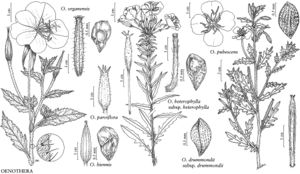Oenothera biennis
Sp. Pl. 1: 346. 1753.
Herbs biennial, densely to sparsely strigillose and villous, with somewhat appressed to spreading hairs, those often pustulate, but sometimes predominantly strigillose, inflorescence sometimes also glandular puberulent. Stems erect, green or flushed with red on proximal parts, sometimes inflorescence axis red, unbranched or with side branches obliquely arising from rosette or stem, 30–200 cm. Leaves in a basal rosette and cauline, basal 10–30 × 2–5 cm, cauline 5–22 ×(1–)1.5–5(–6) cm; blade usually green to pale green, narrowly oblanceolate to oblanceolate, sometimes narrowly elliptic to elliptic distally, margins usually flat, rarely undulate, bluntly dentate, teeth widely spaced, sometimes sinuate-dentate proximally or lobed; bracts persistent. Inflorescences erect, unbranched or with secondary branches just proximal to main one, internodes in fruit usually shorter than capsule. Flowers opening near sunset; buds erect, 3.5–6 mm diam., with free tips terminal, erect or spreading, 1.5–3 mm; floral tube (20–)25–40 mm; sepals yellowish green, rarely flushed with red or red-striped, 12–22(–28) mm; petals yellow to pale yellow, fading yellowish white and somewhat translucent, very broadly obcordate, 12–25(–30) mm; filaments 8–15(–20) mm, anthers 3–6(–9) mm, pollen 50% fertile; style 30–55 mm, stigma surrounded by anthers at anthesis. Capsules erect or slightly spreading, dull green when dry, lanceoloid, 20–40 × 4–6 mm, free tips of valves 0.8–1.5 mm. Seeds 1–1.2 × 0.6–1.1 mm. 2n = 14.
Phenology: Flowering Jul–Sep(–Oct).
Habitat: Open, disturbed sites.
Elevation: 10–700 m.
Distribution
Alta., B.C., Man., N.B., Nfld. and Labr. (Nfld.), N.S., Ont., P.E.I., Que., Sask., Ala., Ark., Calif., Conn., Del., D.C., Fla., Ga., Idaho, Ill., Ind., Iowa, Kans., Ky., La., Maine, Md., Mass., Mich., Minn., Miss., Mo., Mont., Nebr., N.H., N.J., N.Mex., N.Y., N.C., N.Dak., Ohio, Okla., Oreg., Pa., R.I., S.C., S.Dak., Tenn., Tex., Utah, Vt., Va., Wash., W.Va., Wis., introduced nearly worldwide in temperate and subtropical regions.
Discussion
Oenothera biennis is a PTH species and usually forms a ring of 14 chromosomes or a ring of 12 and 1 bivalent in meiosis, and is self-compatible and autogamous (W. Dietrich et al. 1997). It has plastome II and a BA or AB genome composition across different populations.
W. Dietrich et al. (1997) found that in the western half of the United States, where Oenothera biennis is most likely introduced, there are distinctive series of forms that seemed similar to a phenotype of O. biennis that originated in Europe. The most distinctive morphological characters of this western form are the densely villous stems with pustulate hairs and the intense, often dark red color of the stems and sepals, characters which are not typical for the eastern North America forms of O. biennis. The pustulate pubescence of this form is also a characteristic feature of many O. elata and O. villosa subsp. strigosa forms, suggesting possible past hybridization with them. Crossing studies confirm that one of these taxa was most likely involved, and these studies showed that, like O. biennis, they are all AB and BA genomic combinations. One of the seemingly odd features of this form is its scattered distribution across a wide expanse of western states. A possible explanation is that perhaps O. biennis spread westward during glacial periods, hybridized with AA taxa (O. elata and O. villosa subsp. strigosa), followed by compression during warming periods since. A hypothesis of repeated recent hybridization does not seem likely since more typical eastern forms of O. biennis are not present throughout much of the western states. Oenothera biennis hybridizes with the other species of subsect. Oenothera with which it comes in contact, includingO. grandiflora, O. nutans, O. oakesiana, O. parviflora, O. villosa subsp. strigosa, and O. villosa subsp. villosa.
Oenothera biennis subsp. rubricaulis (Klebahn) Stomps is a later homonym that pertains here.
Selected References
None.
